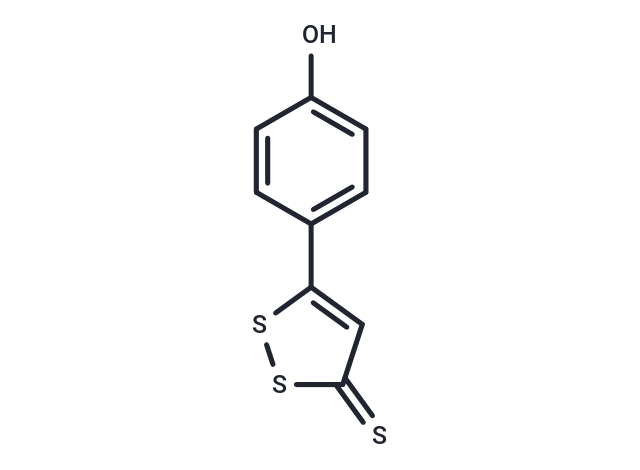 Your shopping cart is currently empty
Your shopping cart is currently empty

Desmethylanethol trithione (ADT-OH) is a derivative of anethole dithiolethione (ADT) and synthetic hydrogen sulfide (H2S) donor. In the in vitro glucose-oxygen deprivation (OGD) model, Desmethylanethol trithione markedly attenuated tPA-enhanced Akt activation and VEGF expression in brain microvascular endothelial cells. Finally, Desmethylanethol trithione improved functional outcomes in mice subjected to MCAO and tPA infusion. H2S donors reduced tPA-induced cerebral hemorrhage by possibly inhibiting the Akt-VEGF-MMP9 cascade. Administration of H2S donors has potential as a novel modality to improve the safety of tPA following the stroke.

| Pack Size | Price | USA Warehouse | Global Warehouse | Quantity |
|---|---|---|---|---|
| 10 mg | $34 | In Stock | In Stock | |
| 25 mg | $59 | In Stock | In Stock | |
| 50 mg | $98 | In Stock | In Stock | |
| 100 mg | $159 | In Stock | In Stock | |
| 200 mg | $236 | - | In Stock | |
| 1 mL x 10 mM (in DMSO) | $29 | In Stock | In Stock |
| Description | Desmethylanethol trithione (ADT-OH) is a derivative of anethole dithiolethione (ADT) and synthetic hydrogen sulfide (H2S) donor. In the in vitro glucose-oxygen deprivation (OGD) model, Desmethylanethol trithione markedly attenuated tPA-enhanced Akt activation and VEGF expression in brain microvascular endothelial cells. Finally, Desmethylanethol trithione improved functional outcomes in mice subjected to MCAO and tPA infusion. H2S donors reduced tPA-induced cerebral hemorrhage by possibly inhibiting the Akt-VEGF-MMP9 cascade. Administration of H2S donors has potential as a novel modality to improve the safety of tPA following the stroke. |
| In vitro | In glucose-oxygen deprivation (OGD) model, ADT-OH markedly attenuated tPA-enhanced Akt activation and VEGF expression in brain microvascular endothelial cells. Finally, ADT-OH improved functional outcomes in mice subjected to MCAO and tPA infusion. |
| Synonyms | ADT-OH |
| Molecular Weight | 226.34 |
| Formula | C9H6OS3 |
| Cas No. | 18274-81-2 |
| Smiles | Oc1ccc(cc1)-c1cc(=S)ss1 |
| Relative Density. | 1.48g/cm3 |
| Color | orange |
| Appearance | Solid |
| Storage | Powder: -20°C for 3 years | In solvent: -80°C for 1 year | Shipping with blue ice/Shipping at ambient temperature. | |||||||||||||||||||||||||||||||||||
| Solubility Information | DMSO: 45 mg/mL (198.82 mM), Sonication is recommended. | |||||||||||||||||||||||||||||||||||
| In Vivo Formulation | 10% DMSO+40% PEG300+5% Tween 80+45% Saline: 2 mg/mL (8.84 mM), Sonication is recommended. Please add the solvents sequentially, clarifying the solution as much as possible before adding the next one. Dissolve by heating and/or sonication if necessary. Working solution is recommended to be prepared and used immediately. The formulation provided above is for reference purposes only. In vivo formulations may vary and should be modified based on specific experimental conditions. | |||||||||||||||||||||||||||||||||||
Solution Preparation Table | ||||||||||||||||||||||||||||||||||||
DMSO
| ||||||||||||||||||||||||||||||||||||
| Size | Quantity | Unit Price | Amount | Operation |
|---|

Copyright © 2015-2025 TargetMol Chemicals Inc. All Rights Reserved.